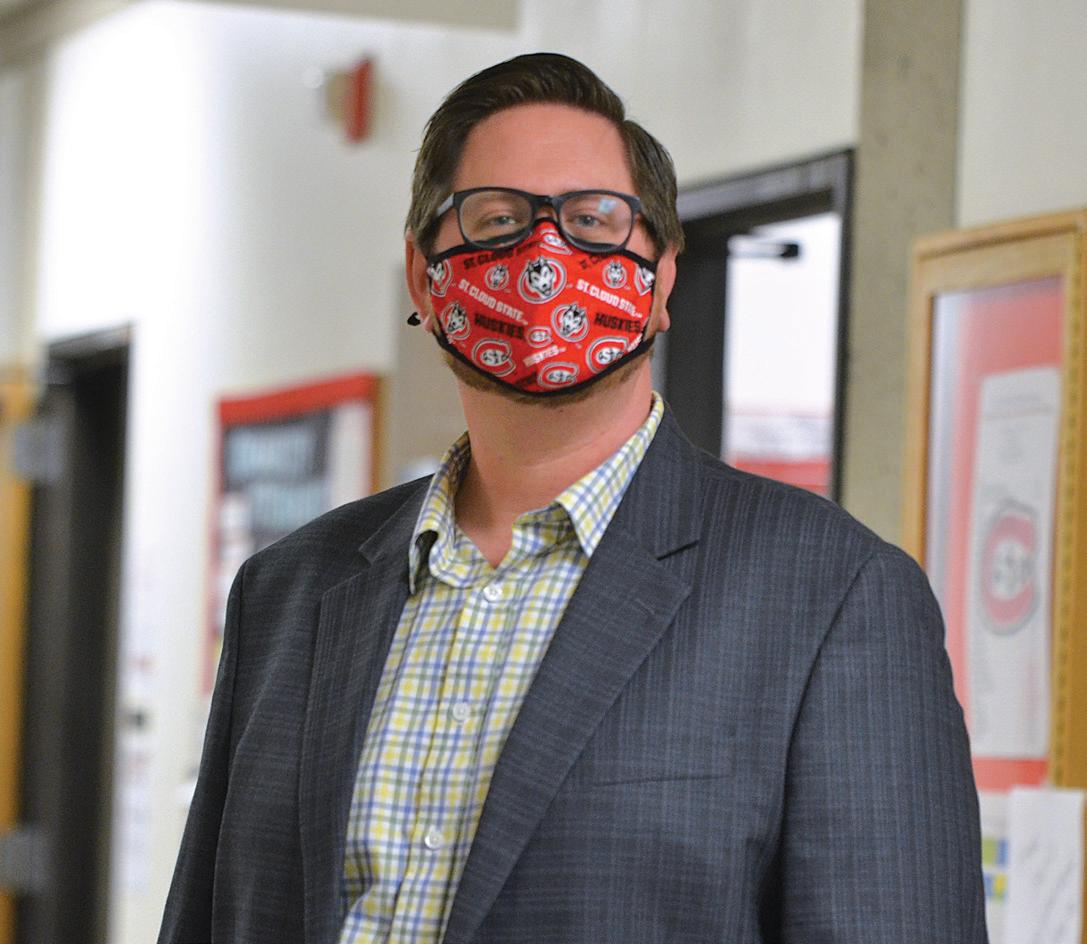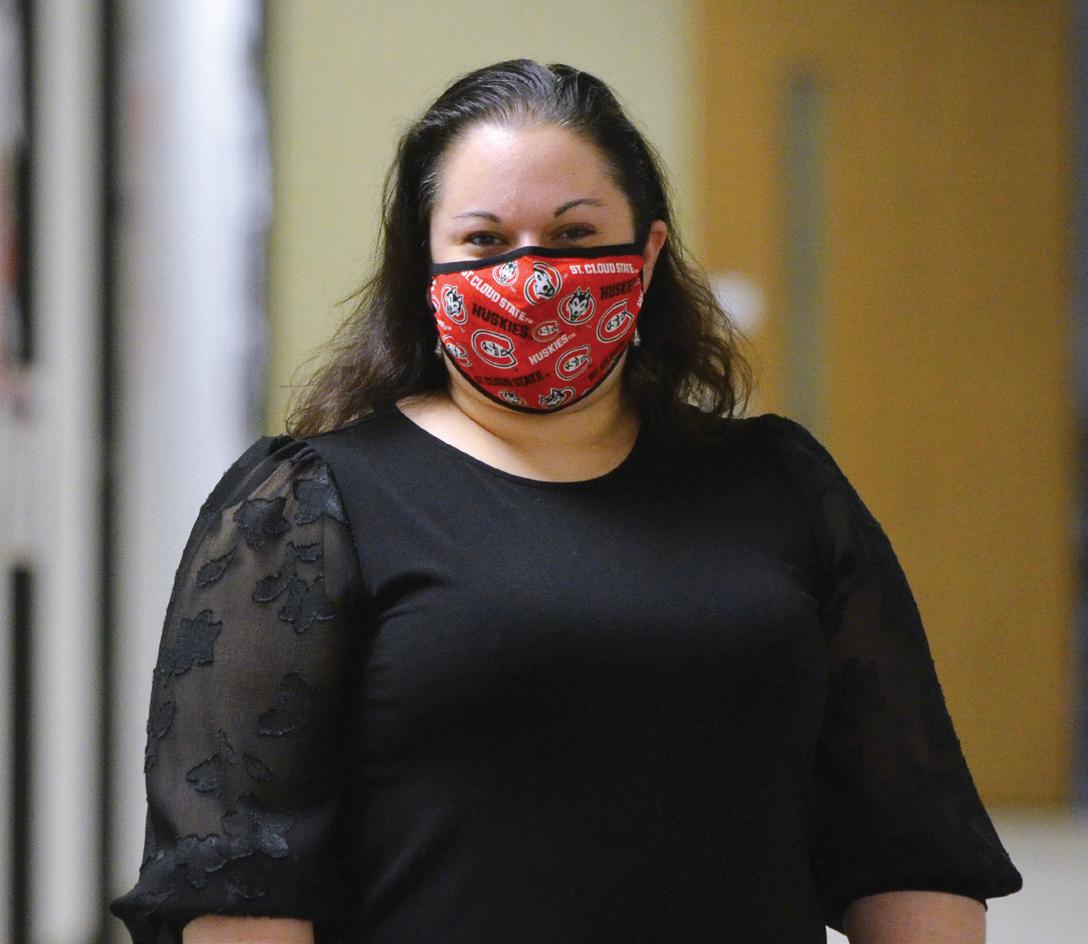
12 minute read
and advocacy on our campus For the greater good: Program
For children diagnosed with an autism spectrum disorder and their families, much needed resources are made accessible with the help of our Applied Behavior Analysis program
For the growing number of families with a child diagnosed with an autism spectrum disorder, it’s fortunate that the world’s top-ranked academic program for educating practitioners to help their children develop and thrive is right here in Central Minnesota. Even better, St. Cloud State’s distinctive Applied Behavior Analysis program is developing progressive on-site services to support the tremendous need for more resources. Applied Behavior Analysis (ABA) is widely FOR THE GREAT considered the most effective type of therapy for autism spectrum disorder, and St. Cloud State has in recent years been ranked the number one academic ABA program in the world, based on first-time pass rates of the board certification exam. The faculty who teach in the program are nationally regarded for their teaching and research in ABA. “We’re the only ABA program of its kind in Minnesota,” said Dr. Shonda Craft, dean of the School of Health and Human Services at St. Cloud State. “Our faculty really live and breathe their field. ER GOOD To them it’s not just about doing the work. They really care about how we can best educate our students to meet those needs.” The pass rate for St. Cloud State graduates applying for board certification has been at or near 100 percent, with the average pass rate being 62 percent, said Dr. Benjamin Witts, chair of our ABA program. “We’re really proud of that.”
BY MARSHA SHOEMAKER Obviously, with such stellar pass rates for its graduates, St. Cloud State’s academic reputation is excellent. But for Witts, the job of preparing students for this work goes deeper. “What makes our program special is we are driven by values and standards that will give students the quality education they need to be the best,” he said. “I fully believe that our students are going out there to save lives.
PREPARING STUDENTS TO SAVE FAMILIES
“We’re saving families when they receive services,” Witts said. “As clients they receive the help they need to have peaceful family dinners, to go out together, go on vacations – many of the things they thought were gone from their family lives.” In addition, he said, “for autistic children our work can be the difference between an adulthood of dependency and one of living and working – of enriching their lives so they can live them to the fullest extent.”
“My approach to teaching my students is preparing them to become practitioners I would trust to work with my own children,” Witts said. “I want students who are okay with tough programs that will help push them farther than they would push themselves, who understand that their work carries great responsibility; that they understand they will have a tremendous effect on the children they will work with and the future of their families.”
It’s estimated that one in 54 American children between the ages of 3 and 17 is diagnosed as autistic, and their families are clamoring for services. “All over Minnesota there are wait lists,” according to Kyle Pollard, who earned his master’s degree in ABA from St. Cloud State and is a behavior analyst at Northway Academy Sartell, an autism service center primarily for children.
Until recently in Minnesota, most of the services for autistic clients have been centered in the Twin Cities and Rochester.
54ONE IN

(Diagnosis made between the ages of 3 and 17)


Dr. Benjamin Witts Professor in the Applied Behavior Analysis program
– DR. BENJAMIN WITTS
Dr. Michele Traub Professor in the Applied Behavior Analysis program
n a growing field with limited training programs, I St. Cloud State’s top-notch online Applied Behavior Analysis classes are brimming with students signing on from every corner of the globe. Since its inception in 2002, ABA’s online programs have educated students from every inhabited continent except Antarctica and every province in Canada. “We don’t advertise it much, and yet we have to reject 60-70 percent of the online applicants because we can’t accommodate them all,” said Dr. Benjamin Witts, chair of the ABA program. It’s one of only a few ABA programs accredited through the Association for Behavior Analysis International offering an all-online master’s degree. Combine that with the fact the St. Cloud State’s is the number one ABA program in the world and it adds up to a winning combination for faculty and students.
“We’re at the top of the line,” said assistant professor Dr. Michele Traub. “The way the program is designed we keep the cohorts small enough that we can succeed at making excellent connections with all our students.”
This fall Witts has formed a cohort of 34 students for his Experimental Analysis of Behavior, which is about as high as he would go for a class. He designs his own customized materials tailored to their needs. “A student in Singapore gets the same experience as the student in Iowa.”
“One of the things I love about teaching in the distance program is seeing the different perspectives of everyone in the classes,” Traub said. “The vast majority of these students work in the field in their home countries.
“They are really able to bring their experiences with state/provincial/national laws and regulations for the work that we do and for autism services into class, so everyone sees not only how our procedures and principles work in theory, but also how they are put into practice,” Traub said. “That is something I purposely work into my distance courses: having the students share the barriers to treatment – or the benefits available – in their countries or regions. It incorporates information they could never get out of a textbook, helps them see the possibilities that are out there for their own work, and, as a teacher, I learn new ways to put the work into context.” Witts agrees. “I’ve loved working in that program,” he said. “It helps make you rethink how to teach essentials and informs teacher assessment.”
“This summer I taught a class on global perspectives on autism treatment, and it was great to hear how people all around the world view the disorder, think about treatment, and advocate for families,” Traub said.
“I had made several international connections in the summer of 2019 with autism professionals in Jakarta, Indonesia; Prague, Czech Republic; Accra, Ghana; Nairobi, Kenya; and Guayaquil, Ecuador, among others,” Traub said. “To have these practitioners share their experiences with our students, and to hear the students’ own experiences working in their communities and how similar many of the struggles are, was fascinating and inspiring all at once.”
Of course, Traub said, the logistics of the distance program also pose a lot of unexpected challenges. “We had a student in Hawaii who was affected by the typhoons a couple years ago; I got an email apologizing for a late assignment because the internet in the evacuation shelter went down. I reassured her that nobody was expecting her to turn in work that week!” “We’ve had students impacted by the California wildfires, the riots in Hong Kong, and, most recently, the travel restrictions due to COVID,” Traub said. “It is humbling to work with students who are so dedicated to their careers and their schooling that they don’t want to ask for accommodations, even when the world is throwing them through the gauntlet.”

– DR. BENJAMIN WITTS
IMAGE BY BOVYNILIN / SHUTTERSTOCK
While centers like Northway are expanding, there’s still not enough space or staff to serve Minnesota families, Pollard said.
St. Cloud State’s Applied Behavior Analysis program is in the midst of a three-phase pilot program to better serve Central Minnesota families with assessments and helping them develop skills in their children that permit a better daily life and more independence.
BUILDING CONFIDENCE THROUGH EXPERIENCE
As a student in the St. Cloud State ABA master’s program, Pollard appreciated the rigors of his courses and the expectations of his professors. “I chose St. Cloud State because of its excellent reputation.”
“I definitely got a good education,” said Pollard, whose undergraduate degree from Central Michigan University was in psychology. “In my master’s program there was a huge emphasis on keeping up on the latest research in the field, on being able to read through it, understand it and think critically.”

Shonda Craft Dean of School of Health and Human Services
– DR. SHONDA CRAFT
Pollard also gained field experience working at Northway while he was a master’s student. Many of St. Cloud State’s ABA students have internships or work experiences at local providers.
For Pollard, the depth of his master’s program helped him build confidence he displays in his work as a practitioner. He serves clients from ages 2 to 21 with a wide variation of needs. “Some come needing social skills or communication skills. Most involve common behaviors demonstrated by the autism population that can affect families.
“For example,” Pollard said, “elopement, mostly running away from parents, is a behavior that we deal with for many clients. This can result in families not wanting to bring their child out into the community, to parks, the grocery store, church, and so forth.”
This behavior may have a variety of causes – running toward something they see and want to pursue or running because they enjoy being chased by their parents. Whatever the cause, elopement behavior can pose dangers to children if they run into traffic or get lost, said Pollard. “We’ll work on having them walk next to their staff and also work on getting them to communicate what they want verbally.”

OFFERING SERVICES, MEETING DEMAND
St. Cloud State’s phased pilot program is already helping to ease the demand for services to families with autistic children in the area. The first phase was offering on-site workshops, where parents and children could come and learn how to adapt to everyday situations like getting through a meal together without disruptive behavior. During each workshop, a team of ABA students and faculty would get to know the children and do light assessments, then bring in parents to give them information on ways to build skills in a loving and caring way at their children’s pace, Witts said.
Last year in the second phase, families were identified that ABA students could work with in their homes, providing more tailored services to families. Students worked directly with clients thanks to an Autism Clinical Training Grant funded by a generous gift to the SCSU Foundation for the ABA department.
A new phase of the pilot program this fall is a telehealth clinic to help respond to families during the limitations created by the coronavirus, providing targeted information and giving feedback to participating families on coping with their challenges.
“Our faculty and students thoroughly research their evidence-based work as they are doing it, creating customized interventions with families,” Craft said.
“The department is working toward an on-site autism clinic that serves students with experiential learning and serves our community,” she said.
EXPANDING AND GROWING
The clinic would be a significant addition to St. Cloud State’s outstanding ABA program, expanding its ability to prepare practitioners with the broad range of knowledge and experience they need to work with clients throughout the autism spectrum.
The clinic, being referred to under the working title of “The Husky Applied Behavior Analysis Training Clinic,” would be an actual ABA clinic on site on campus in the near future. Students would run it under supervision of faculty.
Besides the clinic, the department is looking forward to launching an ABA Doctorate program, bringing in its first class in fall of 2021. “It will be the only program like it to exist in the world,” Witts said. “We’re excited about that.”
Witts explained that our approach to educating students differs from existing doctoral programs in the ABA field as we combine discipline-based knowledge with the applied skills they need to better serve families. “Currently PhDs are working in high level positions or starting their own companies, but their education didn’t prepare them for the other skill sets necessary to get a clinic up and running, supervise, work with families, put on workshops, or deal with administrative aspects as well as providing services,” he said. “With added courses from the Herberger Business School, our practitioner-focused doctorate will help professionals succeed in high level positions and succeed with the business aspects of starting a business.”
For an academic program that already is number one in the world, in a field where graduates are in great demand, the Applied Behavior Analysis program promises to be an increasingly rare and welcome resource for autistic clients and their families.
WE'RE SAVING FAMILIES WHEN THEY RECEIVE SERVICES

Autism spectrum disorder (ASD) is a developmental disability that can cause significant social, communication and behavioral challenges, affecting ways of communicating, interacting, behaving and learning, according to the Centers for Disease Control and Prevention (CDC). “A diagnosis of ASD now includes several conditions that used to be diagnosed separately: autistic disorder, pervasive developmental disorder not otherwise specified (PDD-NOS), and Asperger syndrome. ... The learning, thinking, and problem-solving abilities of people with ASD can range from gifted to severely challenged. Some people with ASD need a lot of help in their daily lives; others need less.”
A child’s autism diagnosis affects every member of the family, according to the Autism Society. “Parents/caregivers must now place their primary focus on helping their child with ASD, which may put stress on their marriage, other children, work, finances, and personal relationships and responsibilities. ... Parents now have to shift much of their resources of time and money towards providing treatment and interventions for their child, to the exclusion of other priorities.”
A child with ASD has needs that complicate relationships among family members, causing stress among parents, siblings.
A study in the Journal of Family Psychology states that parents of autistic children had a 9.7% greater chance of getting divorced than did their peers. According to a study featured in Pediatrics, families with an autistic child underwent an average loss of 14 percent in their entire family income.
Although ASD can be a lifelong disorder, treatments and services can improve a person’s symptoms and ability to function.







